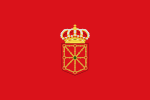Navarre: Difference between revisions
Stephensuleeman (talk | contribs) mNo edit summary |
Energy policy added |
||
| Line 60: | Line 60: | ||
For a fuller account of the history of Navarre, see [[Kingdom of Navarre]]. |
For a fuller account of the history of Navarre, see [[Kingdom of Navarre]]. |
||
==Energy policy== |
|||
Navarra leads Europe in it's use of renewable energy technology, and is planning to reach 100% renewable energy generation by [[2010]]. |
|||
By [[2004]] 61% of the regions' energy was generated by renewable sources, consisting of 43.6% from 28 [[wind farm]]s, 12% from over 100 small-scale [[water turbines]] and 5.3% from 2 [[biomass]] and 2 [[biogas]] plants. In addition, the region had Spain's largest [[photovoltaic]] power plant at Montes de Cierzo de [[Tudela]] (1.2 MWp capacity), plus several hundred smaller photovoltaic installations. |
|||
Developments since 2004 have included further photovoltaic plants at [[Larrión]] (0.25 MWp) [http://www.findarticles.com/p/articles/mi_m0OXD/is_2004_Dec_2/ai_n7635691] and Spain's biggest at [[Castejón]] (2.44 MWp) [http://www.energias-renovables.com/english/Contenidosecciones.asp?ID=7584&Tipo=&Nombre=News]. |
|||
==See also== |
==See also== |
||
Revision as of 15:39, 26 May 2006
- "Navarra" redirects here. For other uses, see Navarre (disambiguation).

|
File:EscudoNavarra.gif |
| Flag | Coat of Arms |

| |
| Capital | Pamplona/Iruña |
| Official languages | Spanish; Basque co-official in the north of community. |
| Area – Total – % of Spain |
Ranked 11th 10 391 km² 2,2% |
| Population – Total (2005) – % of Spain – Density |
Ranked 15th 593 472 1,3% 57,11/km² |
| Demonym – English – Spanish – Basque |
Navarrese navarro/a nafar |
| Statute of Autonomy | August 16, 1982 |
| ISO 3166-2 | NA |
| Parliamentary representation – Congress seats – Senate seats |
5 1 |
| President | Miguel Sanz Sesma (UPN) |
| Gobierno de Navarra | |
Navarre (Spanish Navarra, Basque Nafarroa) is an autonomous community in Spain. Its official Spanish-language name is Comunidad Foral de Navarra (for an explanation of foral, see fuero).
Community
Navarre is bordered on the west by the autonomous community of the Basque Country (formed by the provinces of Vizcaya, Guipúzcoa and Álava, although Navarra only has a border with the latter two), on the south by the autonomous community of La Rioja, on the east by the autonomous community of Aragon (formed by the provinces of Zaragoza/Saragossa, Teruel and Huesca, although Navarra only has a border with Zaragoza and Huesca), and on the north by the country France.
The community is governed as an autonomous region, with its own parliament (Parlamento de Navarra) and government (Gobierno de Navarra). As in other autonomous regions in Spain, health, employment, education and social services, together with housing, urban development, environment protection policies are under the responsibility of its own institutions. Unlike other regions (and like the Basque Country), it has almost full responsibility for collecting taxes, which must follow the overall guidelines established by the Spanish government but may have some minor differences.
There are 272 municipalities in Navarre. See List of municipalities in Navarre. One-third of the population lives in the capital, Pamplona (Basque Iruña).
Cultural Heritage
Navarre is a mixture of the Basque influence from the Pyrenees and the Mediterranean influences coming from the Ebro. The Ebro valley is amenable to wheat, vegetables, wine, and even olive trees, as in Aragon and la Rioja. It was occupied by the Roman Empire and in the Middle Ages it became the taifa kingdom of Tudela. During the Reconquista, the Northerners extended southwards. In the Middle Ages, Pamplona was a crossroads for Basques, Gascons from beyond the Pyrenees and Romance speakers.
The Basque language has been losing ground for centuries. Upper Navarrese is the dialect of the Basque language spoken in the region. Often feelings of "Basqueness" are linked to use of the language. For example, a person from a place where Basque was lost decades ago might say that they are not Basque, but that their grandfather was. Feelings of Basqueness often are carried onto politics with Basque nationalism being stronger in the North, either within Navarrese branches of Basque parties like Batasuna, Aralar, Eusko Alkartasuna or EAJ-PNV or as homegrown movements like Batzarre. Among the parties that downplay links to the Basque Country, there are regional branches of Spanish parties such as the PSOE, as well as regional parties such as UPN (Unión del Pueblo Navarro) and Convergencia de Demócratas Navarros.
History
For a fuller account of the history of Navarre, see Kingdom of Navarre.
Energy policy
Navarra leads Europe in it's use of renewable energy technology, and is planning to reach 100% renewable energy generation by 2010. By 2004 61% of the regions' energy was generated by renewable sources, consisting of 43.6% from 28 wind farms, 12% from over 100 small-scale water turbines and 5.3% from 2 biomass and 2 biogas plants. In addition, the region had Spain's largest photovoltaic power plant at Montes de Cierzo de Tudela (1.2 MWp capacity), plus several hundred smaller photovoltaic installations.
Developments since 2004 have included further photovoltaic plants at Larrión (0.25 MWp) [1] and Spain's biggest at Castejón (2.44 MWp) [2].
